Lantern festival. around the world pptx.
Download as PPTX, PDF0 likes58 views
lantern festivals around the world
1 of 27
Download to read offline

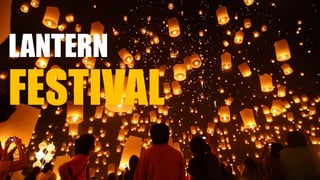

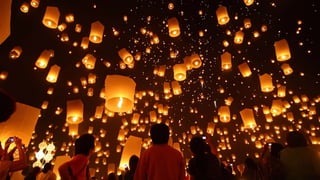
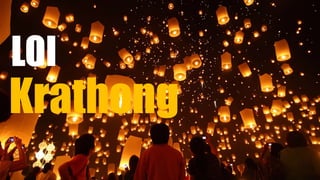
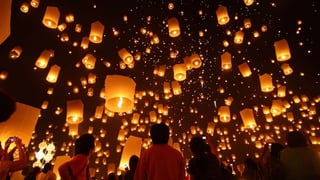
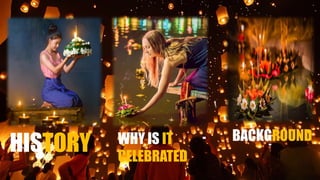
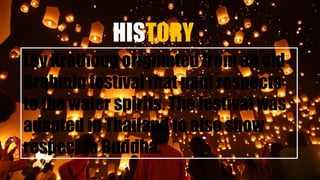
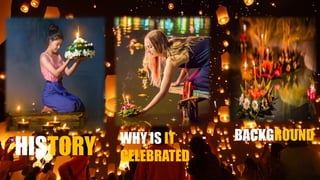
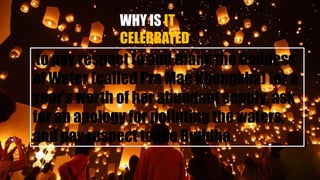
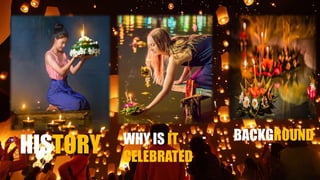
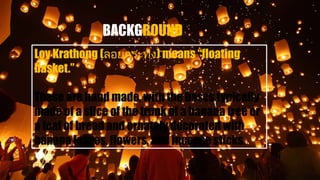
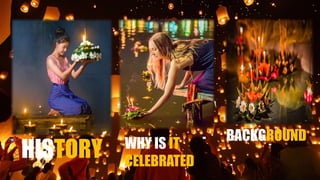

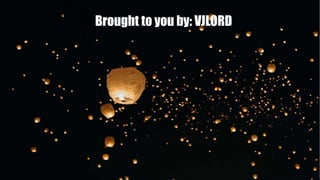
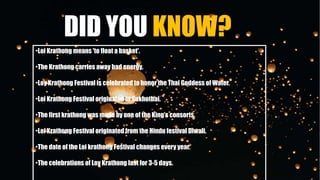
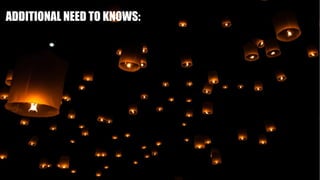

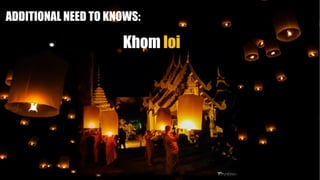



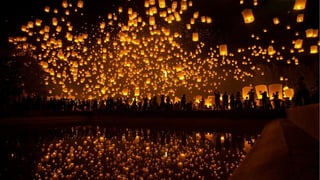
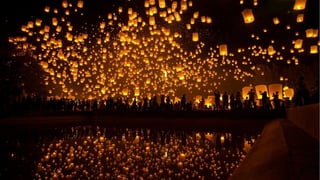

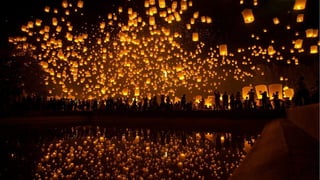
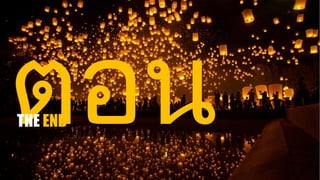
Ad
Recommended
Loy kratong and kodo festival
Loy kratong and kodo festivalangiemangubat
╠²
Loi Krathong is an annual festival celebrated throughout parts of Thailand, Laos, and other Southeast Asian countries on the full moon of the 12th lunar month, usually in November. During the festival, people construct krathong, or decorated floats made of natural materials like banana leaves and flowers, which are launched into waterways to honor the water goddess and symbolize the floating away of bad luck. The exact origins of the tradition are unclear but involve paying respect to gods and spirits and asking for good fortune.Loy krathong history
Loy krathong historyChainarong Maharak
╠²
Loy Krathong is a Thai festival held annually on the full moon of the 12th lunar month where people float krathong (small rafts made from banana leaves) on rivers, canals and other bodies of water. It is believed that floating krathongs carries away sins and bad luck. The festival celebrates gratitude to the goddess of water. People light candles and incense on their krathongs, make a wish and float them away. There are also beauty contests and fireworks displays during the Loy Krathong celebrations.Little known or misunderstood
Little known or misunderstoodErin Stehlik
╠²
The document discusses traditions of lantern festivals in Thailand, China, and the United States. It describes how the Thai Loi Krathong festival originated as a religious ceremony to thank Buddha and cleanse sins, but now includes beauty pageants and decorating boats with candles and flowers. The Chinese lantern festival celebrates spring and family, with lanterns in shapes and colors, riddles, lion dances, and dumplings. While the Asian festivals had religious origins, the growing lantern festivals in the US focus more on social gathering. All three cultures now approach lantern traditions differently while celebrating the symbol of floating lanterns.Songkran: Tradition, Culture & Celebration
Songkran: Tradition, Culture & CelebrationVisitsmiles
╠²
Songkran, ThailandŌĆÖs traditional New Year festival, is celebrated from April 13 to 15 with vibrant water fights, cultural rituals, and spiritual significance. Originally marking the sunŌĆÖs movement between zodiac signs, Songkran is a time for visiting temples, making merit, and paying respects to elders. While water fights symbolize washing away bad luck, the festival also involves traditional practices like cleansing Buddha statues and building sand pagodas. Experience the best of Songkran with VisitSmiles, where we offer tailored travel packages to explore both the traditional and festive sides of this exciting celebration!Loy Krathong Festivals
Loy Krathong FestivalsChainarong Maharak
╠²
Loy Krathong is a major Thai festival celebrated on the full moon of the twelfth lunar month, marked by floating lotus-shaped vessels called krathongs in rivers and canals to offer thanks to the water goddess. Participants light candles and make wishes as they launch their krathongs, symbolizing the release of sins and bad luck. The festival also includes beauty contests, fireworks, and regional variations, attracting tourists and locals alike to join in the celebration.Loy kratong-festival
Loy kratong-festivalÓĖüÓĖżÓĖ®ÓĖÄÓĖ▓ ÓĖÜÓĖĖÓĖŹÓ╣ĆÓĖŖÓĖ┤ÓĖö
╠²
The Loy Kratong festival is a Thai festival held annually in November where people float krathong (small rafts made from banana leaves and decorated with flowers, candles, and incense) on rivers and canals to worship the river goddess and float away misfortune. It is celebrated on the full moon of the 12th lunar month. In Chiang Mai it is called Yee Peng where people float lanterns into the sky instead of krathong. In Tak people make krathong out of coconut shells threaded together called Loy Kratong Sai. The festival celebrates gratitude for water and forgiveness for pollution in the rivers while bringing good fortune for the coming year.Traditional Festivals in Thailand: A Vibrant Tapestry of Culture and Celebration
Traditional Festivals in Thailand: A Vibrant Tapestry of Culture and CelebrationKaustubh Wankhede
╠²
Thailand's traditional festivals are a vibrant showcase of its rich culture, featuring events like Songkran, Loy Krathong, and the Elephant Festival that highlight joy, community, and spirituality. These celebrations, from water fights and floating lanterns to parades of elephants, offer unique experiences that attract both locals and tourists. Each festival serves as a reminder of Thailand's cultural heritage and deep connection to nature, making it a must-visit destination for those seeking authentic experiences.Thailand's Sky Lantern (Yi Peng) MAPEH 8
Thailand's Sky Lantern (Yi Peng) MAPEH 8John Michael Gian
╠²
The document discusses the Sky Lantern Festival in Thailand, also known as the Loi Krathong festival. It is held on the full moon of the 12th month in the traditional Thai lunar calendar, usually in November. People launch sky lanterns, which are small hot air balloons, to send prayers, wishes, or to float away bad luck and problems. Releasing sky lanterns is believed to bring good fortune. The festival originated as an ancient practice of honoring the river spirits by floating krathong, small rafts made of banana leaves and candles, down rivers.Cultural Festivals in Thailand You Shouldn.pdf
Cultural Festivals in Thailand You Shouldn.pdfabadimuneernabeel
╠²
Thailand's vibrant cultural festivals, such as Songkran, Loy Krathong, and Phi Ta Khon, offer travelers a unique glimpse into the nation's traditions, history, and local customs. Each festival is a celebration filled with lively activities, from playful water fights to mesmerizing lantern releases, providing unforgettable experiences that connect visitors with Thai culture. Planning ahead for visa requirements and being prepared for the festivities ensures a smooth and enriching trip to these colorful events.Present Loy Krathong Festival
Present Loy Krathong FestivalSleeperCat
╠²
Loy Krathong Festival is a Thai festival held on the full moon of the 12th month in the traditional Thai lunar calendar, usually in November in the Western calendar. During the festival, people float small rafts called krathong, made of banana leaves and decorated with flowers and candles, down rivers and canals to honor the goddess of water. The festival includes beauty pageants, fireworks, and the tradition of carving vegetables. It began in Sukhothai but is now celebrated nationwide, particularly in Chiang Mai where sky lanterns are also launched into the air.4 of the best events and festivals in Laos
4 of the best events and festivals in Laosjathinraokeer37
╠²
Laos is celebrated for its vibrant festivals such as Pi Mai (Lao New Year), That Luang Festival, Boun Bang Fai (Rocket Festival), and Boun Ok Phansa and Lai Heua Fai (End of Buddhist Lent), which reflect its rich cultural and religious traditions. These events feature various activities including water fights, spiritual rituals, colorful processions, and community celebrations that allow visitors to immerse themselves in Lao culture. Overall, participating in these festivals offers travelers a unique opportunity to experience the local way of life and the warmth of the Lao people.ThailandŌĆÖs Hidden Cultural Festivals....
ThailandŌĆÖs Hidden Cultural Festivals....Visitsmiles
╠²
Thailand is famous for its vibrant celebrations, with Songkran (the Thai New Year) being the most well-known. However, beyond the water fights and lantern festivals, the country is home to numerous hidden gemsŌĆöfestivals that offer a deeper look into its rich culture, spirituality, and local traditions. These lesser-known celebrations are deeply rooted in history and provide a unique experience for those seeking something beyond the usual tourist attractions.
From the ghostly parades of Phi Ta Khon to the sky-bound rockets of Boon Bang Fai, each festival tells a story of faith, folklore, and community spirit. The Chak Phra Festival in Southern Thailand brings rivers to life with elaborate boat processions honoring Buddha, while the Surin Elephant Round-Up showcases ThailandŌĆÖs deep connection with its revered elephants.
For those drawn to spiritual devotion, the Vegetarian Festival in Phuket is a must-see, with devotees undergoing extreme rituals for purification. Meanwhile, the Poi Sang Long festival offers a touching glimpse into a young boyŌĆÖs journey into monkhood, celebrated with royal-like processions. And in Lopburi, the Monkey Banquet Festival flips the script, as thousands of monkeys are honored with a grand feast, blending religion, superstition, and fun.
These festivals remain relatively undiscovered by mainstream tourism, making them perfect for travelers seeking authentic experiences. Whether you're looking for spiritual enlightenment, adrenaline-pumping spectacles, or cultural immersion, ThailandŌĆÖs hidden festivals promise a journey off the beaten path and into the heart of its traditionsThe Unique Water Festivals Of Southeast Asia.pdf
The Unique Water Festivals Of Southeast Asia.pdfVietnam Fast Tours
╠²
Southeast Asia's water festivals, including Laos' Pi Mai, Thailand's Songkran, and Cambodia's Chol Chnam Thmay, celebrate the new year with traditions centered around water as a symbol of renewal and blessings. Each festival has its unique flavor, from Laos' ritual cleansing and community togetherness to Thailand's lively water fights and Cambodia's spiritual gatherings. Travelers interested in these vibrant cultures can explore personalized tour options to experience the depth and joy of these celebrations firsthand.Asian festivals (China, Japan, Indonesia, and Thailand)
Asian festivals (China, Japan, Indonesia, and Thailand)fiacajayon
╠²
This document summarizes several festivals celebrated in Asian countries:
- Chinese Spring Festival/New Year celebrations include traditions like cleaning homes, decorating with red paper, family dinners, firecrackers, giving money in red envelopes, and dragon dances.
- Japan's Taiko Drum Festival features performances by troupes like Kodo using different sized drums and costumes like happi coats.
- Balinese Dance Festival showcases ancient dances from the Hindu tradition with variations like Legong and Kecak. Training starts young and incorporates intricate hand movements and costumes.
- Thailand's Lantern Festivals include the Sky Lantern Festival in November where lanterns carry prayers and wishes, and Loy Krathong whereLoy Krathong Festival.
Loy Krathong Festival.Guntima Pisaidsin
╠²
1) Loy Krathong is a Thai festival held annually on the full moon of the 12th lunar month where people float krathong (banana-leaf boats with candles) down rivers and canals to wash away bad luck and misfortune from the previous year.
2) The festival originated in the Sukhothai period under King Ramkhamhaeng as a way to worship Buddha's footprint and pay tribute to the water goddess.
3) Today, Loy Krathong celebrations include contests, performances, fireworks and floating krathongs while making wishes for good fortune in the coming year.Festivals 1ESO B
Festivals 1ESO Bmontsealmata
╠²
The Holi festival is a popular spring festival in India celebrated with colored powders thrown and people painted. The Carnival of Venice lasts two weeks before Ash Wednesday and ends on Shrove Tuesday, known for distinctive masks allowing people to hide their identity. The Pingxi lantern festival in Taiwan has thousands of lanterns decorated with wishes to ward off evil. Up Helly Aa in Scotland marks the end of Christmas with a parade of up to 1000 costumed participants in squads.Welcome to thailand ( new edition)
Welcome to thailand ( new edition)Kaniknan Wongsuradit
╠²
Thailand has an area of 514,000 square kilometers and a population of over 63 million people. It borders Burma, Laos, Cambodia and Malaysia. Bangkok is the capital city, and most Thai people practice Buddhism. Some of Thailand's major festivals include Songkran (Thai New Year) in April, when water is thrown to celebrate, and Loy Krathong in November, when small rafts made of banana leaves and candles are floated in water. Popular Thai sports include Muay Thai (Thai boxing), sword and pole fighting, boat racing, kite flying, and takro (kick volleyball). Thai cuisine uses five basic flavors - sweet, sour, salty, spicy and bitter - and is known for dishesEmbracing Festivities Of The New Year Celebrations in Laos.pdf
Embracing Festivities Of The New Year Celebrations in Laos.pdfVietnam Fast Tours
╠²
The document outlines the vibrant traditions and celebrations of Pi Mai Laos, the Laotian New Year, which occurs from April 13th to 15th. Key highlights include festivities in Luang Prabang and Vientiane featuring parades, beauty contests, and water fights, as well as unique rituals like sand stupa building and baci ceremonies to invoke blessings. It emphasizes the importance of planning ahead for accommodations and personal safety during the lively celebrations.powerpoint music and arts quarter 1 grade 8
powerpoint music and arts quarter 1 grade 8suzanneannertabangcu
╠²
Thailand is known for never being ruled by Western powers and for its fine silk making tradition. Two important Thai festivals involving floating lanterns are Yi Peng and Loy Krathong. Loy Krathong occurs in November and involves floating krathong baskets to release bad luck and make wishes. Traditional Thai music features three primary instrumental ensembles including piphat, khrueang sai, and mahori. Other Southeast Asian countries like Cambodia, Malaysia, Indonesia, Laos, Vietnam, Singapore, and Brunei also have rich artistic and musical traditions centered around fabrics, sculptures, crafts, and styles of music performance.Loy Krathong Transformed
Loy Krathong Transformedddangers
╠²
1) The document explores redesigning a seasonal Thai festival called Loy Krathong to reflect the author's experience of living with multiple cultures in both Thailand and New England.
2) Loy Krathong is traditionally celebrated in Thailand by floating small boats called krathongs down rivers to give thanks to the river goddess for providing water for crops.
3) The author redesigned Loy Krathong for New England by using local spring flowers, Easter eggs, and materials to float krathongs on a local river, keeping the ritual's essence of celebrating nature while reflecting their multicultural identity.Chinese Famous Festivals
Chinese Famous FestivalsPadme Amidala
╠²
The document summarizes several important Chinese festivals, including their timing, location, and activities. It discusses the New Year of the Miao Ethnic Group celebrated in November in Guizhou with bull fighting and horse racing. The Shoton Festival in Tibet in August features opera performances and drinking yogurt. The Water Splashing Festival in Yunnan in April involves splashing water on each other. It also briefly outlines Chinese New Year, the Lantern Festival, Winter Solstice Festival, Qingming Festival, Dragon Boat Festival, Double Seventh Festival, and Mid-Autumn Festival, noting their cultural significance and traditional celebrations.chinese.pdf
chinese.pdfdanzo7
╠²
The document provides information on several important Chinese festivals, including their dates, locations, and activities. It discusses the New Year of the Miao Ethnic Group celebrated in November in Guizhou with bull fighting and horse racing. The Shoton Festival in Tibet in August features opera performances and drinking yogurt. The Water Splashing Festival in Yunnan in April involves splashing water on each other. It also summarizes Chinese New Year celebrations, the Lantern Festival, Winter Solstice Festival, Qingming Festival, Dragon Boat Festival, Double Seventh Festival, and Mid-Autumn Festival.Cultural activities in Hua Hin
Cultural activities in Hua HinCaleb Falcon
╠²
The document provides an overview of festivals and cultural activities in Hua Hin from January to June, including significant events such as New Year's Day, Chinese New Year, the International Kite Festival, Songkran, Visakha Bucha, and the Hua Hin Jazz Festival. It also offers insights on the best times to visit Hua Hin, recommended accommodation, and local culinary specialties. Additional details include cultural significance and activities associated with each festival.Cultural activities in Hua Hin
Cultural activities in Hua HinCaleb Falcon
╠²
The document provides an overview of festivals and cultural activities in Hua Hin from January to June, including notable events such as New Year's Day, Chinese New Year, the International Kite Festival, Songkran, Visakha Bucha, and the Hua Hin Jazz Festival. It also offers travel tips, including the best time to visit and accommodations. Additionally, it highlights local culinary specialties and cultural sites like Wat Huay Mongkol.Dragon Boat Festival
Dragon Boat FestivalCarlmont Chinese
╠²
The Dragon Boat Festival is an important Chinese tradition celebrated on the 5th day of the 5th month of the lunar calendar. Key customs include dragon boat races where teams compete to collect flags, and the eating of zongzi, a glutinous rice dumpling. Superstitions during this time include hanging herbs to ward off pests and wearing spice bags or necklaces to protect against disease, as the 5th month was thought to be an unlucky, plague-ridden time. Traditional foods vary regionally but always include zongzi, while realgar wine was drunk for its believed protective properties.Dive into Thailand's songkran festival :Tuk tuk in Bangkok
Dive into Thailand's songkran festival :Tuk tuk in BangkokJust xplore
╠²
Experience Thailand's Songkran festival, a vibrant celebration of the new year marked by water battles, temple visits, and cultural performances. The water symbolizes cleansing and welcoming good fortune, while festivities include traditional food, music, and community parades. Plan your adventure for April 13th to 15th, ensuring accommodations and flights are booked in advance to fully embrace the unique Thai cultural spirit.The kingdom of thailand 2013
The kingdom of thailand 2013Fhatin Amelia
╠²
The document provides an overview of Thai culture, traditions, and customs. It discusses Buddhism in Thailand and the Thai language. It describes various rituals associated with engagement, marriage, birth, death, and festivals. Key points include:
- Thai Buddhism is Theravada Buddhism, which focuses on individual emancipation through one's own efforts.
- Important Thai festivals include Songkran (water festival), Phi Ta Khon (ghost festival), and Loy Krathong (floating lantern festival).
- Marriage customs involve a groom's presents parade, gate passing ceremony, and arranging the pillow ceremony.
- Birth rituals include a khwan ceremony, fire-shaving5-ESTUDOSOBRE As Trevas e a Luz - ANÁLISE TEOLOGICA .pdf
5-ESTUDOSOBRE As Trevas e a Luz - ANÁLISE TEOLOGICA .pdfLeomar Ferreira
╠²
As Trevas e a Luz - ANÁLISE TEOLOGICAMore Related Content
Similar to Lantern festival. around the world pptx. (20)
Thailand's Sky Lantern (Yi Peng) MAPEH 8
Thailand's Sky Lantern (Yi Peng) MAPEH 8John Michael Gian
╠²
The document discusses the Sky Lantern Festival in Thailand, also known as the Loi Krathong festival. It is held on the full moon of the 12th month in the traditional Thai lunar calendar, usually in November. People launch sky lanterns, which are small hot air balloons, to send prayers, wishes, or to float away bad luck and problems. Releasing sky lanterns is believed to bring good fortune. The festival originated as an ancient practice of honoring the river spirits by floating krathong, small rafts made of banana leaves and candles, down rivers.Cultural Festivals in Thailand You Shouldn.pdf
Cultural Festivals in Thailand You Shouldn.pdfabadimuneernabeel
╠²
Thailand's vibrant cultural festivals, such as Songkran, Loy Krathong, and Phi Ta Khon, offer travelers a unique glimpse into the nation's traditions, history, and local customs. Each festival is a celebration filled with lively activities, from playful water fights to mesmerizing lantern releases, providing unforgettable experiences that connect visitors with Thai culture. Planning ahead for visa requirements and being prepared for the festivities ensures a smooth and enriching trip to these colorful events.Present Loy Krathong Festival
Present Loy Krathong FestivalSleeperCat
╠²
Loy Krathong Festival is a Thai festival held on the full moon of the 12th month in the traditional Thai lunar calendar, usually in November in the Western calendar. During the festival, people float small rafts called krathong, made of banana leaves and decorated with flowers and candles, down rivers and canals to honor the goddess of water. The festival includes beauty pageants, fireworks, and the tradition of carving vegetables. It began in Sukhothai but is now celebrated nationwide, particularly in Chiang Mai where sky lanterns are also launched into the air.4 of the best events and festivals in Laos
4 of the best events and festivals in Laosjathinraokeer37
╠²
Laos is celebrated for its vibrant festivals such as Pi Mai (Lao New Year), That Luang Festival, Boun Bang Fai (Rocket Festival), and Boun Ok Phansa and Lai Heua Fai (End of Buddhist Lent), which reflect its rich cultural and religious traditions. These events feature various activities including water fights, spiritual rituals, colorful processions, and community celebrations that allow visitors to immerse themselves in Lao culture. Overall, participating in these festivals offers travelers a unique opportunity to experience the local way of life and the warmth of the Lao people.ThailandŌĆÖs Hidden Cultural Festivals....
ThailandŌĆÖs Hidden Cultural Festivals....Visitsmiles
╠²
Thailand is famous for its vibrant celebrations, with Songkran (the Thai New Year) being the most well-known. However, beyond the water fights and lantern festivals, the country is home to numerous hidden gemsŌĆöfestivals that offer a deeper look into its rich culture, spirituality, and local traditions. These lesser-known celebrations are deeply rooted in history and provide a unique experience for those seeking something beyond the usual tourist attractions.
From the ghostly parades of Phi Ta Khon to the sky-bound rockets of Boon Bang Fai, each festival tells a story of faith, folklore, and community spirit. The Chak Phra Festival in Southern Thailand brings rivers to life with elaborate boat processions honoring Buddha, while the Surin Elephant Round-Up showcases ThailandŌĆÖs deep connection with its revered elephants.
For those drawn to spiritual devotion, the Vegetarian Festival in Phuket is a must-see, with devotees undergoing extreme rituals for purification. Meanwhile, the Poi Sang Long festival offers a touching glimpse into a young boyŌĆÖs journey into monkhood, celebrated with royal-like processions. And in Lopburi, the Monkey Banquet Festival flips the script, as thousands of monkeys are honored with a grand feast, blending religion, superstition, and fun.
These festivals remain relatively undiscovered by mainstream tourism, making them perfect for travelers seeking authentic experiences. Whether you're looking for spiritual enlightenment, adrenaline-pumping spectacles, or cultural immersion, ThailandŌĆÖs hidden festivals promise a journey off the beaten path and into the heart of its traditionsThe Unique Water Festivals Of Southeast Asia.pdf
The Unique Water Festivals Of Southeast Asia.pdfVietnam Fast Tours
╠²
Southeast Asia's water festivals, including Laos' Pi Mai, Thailand's Songkran, and Cambodia's Chol Chnam Thmay, celebrate the new year with traditions centered around water as a symbol of renewal and blessings. Each festival has its unique flavor, from Laos' ritual cleansing and community togetherness to Thailand's lively water fights and Cambodia's spiritual gatherings. Travelers interested in these vibrant cultures can explore personalized tour options to experience the depth and joy of these celebrations firsthand.Asian festivals (China, Japan, Indonesia, and Thailand)
Asian festivals (China, Japan, Indonesia, and Thailand)fiacajayon
╠²
This document summarizes several festivals celebrated in Asian countries:
- Chinese Spring Festival/New Year celebrations include traditions like cleaning homes, decorating with red paper, family dinners, firecrackers, giving money in red envelopes, and dragon dances.
- Japan's Taiko Drum Festival features performances by troupes like Kodo using different sized drums and costumes like happi coats.
- Balinese Dance Festival showcases ancient dances from the Hindu tradition with variations like Legong and Kecak. Training starts young and incorporates intricate hand movements and costumes.
- Thailand's Lantern Festivals include the Sky Lantern Festival in November where lanterns carry prayers and wishes, and Loy Krathong whereLoy Krathong Festival.
Loy Krathong Festival.Guntima Pisaidsin
╠²
1) Loy Krathong is a Thai festival held annually on the full moon of the 12th lunar month where people float krathong (banana-leaf boats with candles) down rivers and canals to wash away bad luck and misfortune from the previous year.
2) The festival originated in the Sukhothai period under King Ramkhamhaeng as a way to worship Buddha's footprint and pay tribute to the water goddess.
3) Today, Loy Krathong celebrations include contests, performances, fireworks and floating krathongs while making wishes for good fortune in the coming year.Festivals 1ESO B
Festivals 1ESO Bmontsealmata
╠²
The Holi festival is a popular spring festival in India celebrated with colored powders thrown and people painted. The Carnival of Venice lasts two weeks before Ash Wednesday and ends on Shrove Tuesday, known for distinctive masks allowing people to hide their identity. The Pingxi lantern festival in Taiwan has thousands of lanterns decorated with wishes to ward off evil. Up Helly Aa in Scotland marks the end of Christmas with a parade of up to 1000 costumed participants in squads.Welcome to thailand ( new edition)
Welcome to thailand ( new edition)Kaniknan Wongsuradit
╠²
Thailand has an area of 514,000 square kilometers and a population of over 63 million people. It borders Burma, Laos, Cambodia and Malaysia. Bangkok is the capital city, and most Thai people practice Buddhism. Some of Thailand's major festivals include Songkran (Thai New Year) in April, when water is thrown to celebrate, and Loy Krathong in November, when small rafts made of banana leaves and candles are floated in water. Popular Thai sports include Muay Thai (Thai boxing), sword and pole fighting, boat racing, kite flying, and takro (kick volleyball). Thai cuisine uses five basic flavors - sweet, sour, salty, spicy and bitter - and is known for dishesEmbracing Festivities Of The New Year Celebrations in Laos.pdf
Embracing Festivities Of The New Year Celebrations in Laos.pdfVietnam Fast Tours
╠²
The document outlines the vibrant traditions and celebrations of Pi Mai Laos, the Laotian New Year, which occurs from April 13th to 15th. Key highlights include festivities in Luang Prabang and Vientiane featuring parades, beauty contests, and water fights, as well as unique rituals like sand stupa building and baci ceremonies to invoke blessings. It emphasizes the importance of planning ahead for accommodations and personal safety during the lively celebrations.powerpoint music and arts quarter 1 grade 8
powerpoint music and arts quarter 1 grade 8suzanneannertabangcu
╠²
Thailand is known for never being ruled by Western powers and for its fine silk making tradition. Two important Thai festivals involving floating lanterns are Yi Peng and Loy Krathong. Loy Krathong occurs in November and involves floating krathong baskets to release bad luck and make wishes. Traditional Thai music features three primary instrumental ensembles including piphat, khrueang sai, and mahori. Other Southeast Asian countries like Cambodia, Malaysia, Indonesia, Laos, Vietnam, Singapore, and Brunei also have rich artistic and musical traditions centered around fabrics, sculptures, crafts, and styles of music performance.Loy Krathong Transformed
Loy Krathong Transformedddangers
╠²
1) The document explores redesigning a seasonal Thai festival called Loy Krathong to reflect the author's experience of living with multiple cultures in both Thailand and New England.
2) Loy Krathong is traditionally celebrated in Thailand by floating small boats called krathongs down rivers to give thanks to the river goddess for providing water for crops.
3) The author redesigned Loy Krathong for New England by using local spring flowers, Easter eggs, and materials to float krathongs on a local river, keeping the ritual's essence of celebrating nature while reflecting their multicultural identity.Chinese Famous Festivals
Chinese Famous FestivalsPadme Amidala
╠²
The document summarizes several important Chinese festivals, including their timing, location, and activities. It discusses the New Year of the Miao Ethnic Group celebrated in November in Guizhou with bull fighting and horse racing. The Shoton Festival in Tibet in August features opera performances and drinking yogurt. The Water Splashing Festival in Yunnan in April involves splashing water on each other. It also briefly outlines Chinese New Year, the Lantern Festival, Winter Solstice Festival, Qingming Festival, Dragon Boat Festival, Double Seventh Festival, and Mid-Autumn Festival, noting their cultural significance and traditional celebrations.chinese.pdf
chinese.pdfdanzo7
╠²
The document provides information on several important Chinese festivals, including their dates, locations, and activities. It discusses the New Year of the Miao Ethnic Group celebrated in November in Guizhou with bull fighting and horse racing. The Shoton Festival in Tibet in August features opera performances and drinking yogurt. The Water Splashing Festival in Yunnan in April involves splashing water on each other. It also summarizes Chinese New Year celebrations, the Lantern Festival, Winter Solstice Festival, Qingming Festival, Dragon Boat Festival, Double Seventh Festival, and Mid-Autumn Festival.Cultural activities in Hua Hin
Cultural activities in Hua HinCaleb Falcon
╠²
The document provides an overview of festivals and cultural activities in Hua Hin from January to June, including significant events such as New Year's Day, Chinese New Year, the International Kite Festival, Songkran, Visakha Bucha, and the Hua Hin Jazz Festival. It also offers insights on the best times to visit Hua Hin, recommended accommodation, and local culinary specialties. Additional details include cultural significance and activities associated with each festival.Cultural activities in Hua Hin
Cultural activities in Hua HinCaleb Falcon
╠²
The document provides an overview of festivals and cultural activities in Hua Hin from January to June, including notable events such as New Year's Day, Chinese New Year, the International Kite Festival, Songkran, Visakha Bucha, and the Hua Hin Jazz Festival. It also offers travel tips, including the best time to visit and accommodations. Additionally, it highlights local culinary specialties and cultural sites like Wat Huay Mongkol.Dragon Boat Festival
Dragon Boat FestivalCarlmont Chinese
╠²
The Dragon Boat Festival is an important Chinese tradition celebrated on the 5th day of the 5th month of the lunar calendar. Key customs include dragon boat races where teams compete to collect flags, and the eating of zongzi, a glutinous rice dumpling. Superstitions during this time include hanging herbs to ward off pests and wearing spice bags or necklaces to protect against disease, as the 5th month was thought to be an unlucky, plague-ridden time. Traditional foods vary regionally but always include zongzi, while realgar wine was drunk for its believed protective properties.Dive into Thailand's songkran festival :Tuk tuk in Bangkok
Dive into Thailand's songkran festival :Tuk tuk in BangkokJust xplore
╠²
Experience Thailand's Songkran festival, a vibrant celebration of the new year marked by water battles, temple visits, and cultural performances. The water symbolizes cleansing and welcoming good fortune, while festivities include traditional food, music, and community parades. Plan your adventure for April 13th to 15th, ensuring accommodations and flights are booked in advance to fully embrace the unique Thai cultural spirit.The kingdom of thailand 2013
The kingdom of thailand 2013Fhatin Amelia
╠²
The document provides an overview of Thai culture, traditions, and customs. It discusses Buddhism in Thailand and the Thai language. It describes various rituals associated with engagement, marriage, birth, death, and festivals. Key points include:
- Thai Buddhism is Theravada Buddhism, which focuses on individual emancipation through one's own efforts.
- Important Thai festivals include Songkran (water festival), Phi Ta Khon (ghost festival), and Loy Krathong (floating lantern festival).
- Marriage customs involve a groom's presents parade, gate passing ceremony, and arranging the pillow ceremony.
- Birth rituals include a khwan ceremony, fire-shavingRecently uploaded (20)
5-ESTUDOSOBRE As Trevas e a Luz - ANÁLISE TEOLOGICA .pdf
5-ESTUDOSOBRE As Trevas e a Luz - ANÁLISE TEOLOGICA .pdfLeomar Ferreira
╠²
As Trevas e a Luz - ANÁLISE TEOLOGICASabbath School Lesson 11, 2nd Quarter 2025.pptx
Sabbath School Lesson 11, 2nd Quarter 2025.pptxDavidSyahputra4
╠²
Sabbath School Lesson 11, 2nd Quarter 2025.pptxMonthly Khazina-e-Ruhaniyaat JunŌĆÖ2025 (Vol.16, Issue 2)
Monthly Khazina-e-Ruhaniyaat JunŌĆÖ2025 (Vol.16, Issue 2)Darul Amal Chishtia
╠²
2nd issue of Volume 16. A magazine in urdu language mainly based on spiritual treatment and learning. Many topics on ISLAM, SUFISM, SOCIAL PROBLEMS, SELF HELP, PSYCHOLOGY, HEALTH, SPIRITUAL TREATMENT, Ruqya etc. A very useful magazine for everyone.Homily for the Funeral of Derek DiGregorio.docx
Homily for the Funeral of Derek DiGregorio.docxJames Knipper
╠²
This morning our parish came together to mourn the passing of a dear friend, Derek DiGrgorio. Being diagnosed around the age of ten with Ataxia Telangiectasia, over half his life his ministry to others came from the position of sitting in a wheelchair. His gift ŌĆō his blessing to me and to all those around him was teaching us how he faced adversity ŌĆō how to take it head onŌĆ”and with the grace of God, how we convert those challenges to advantages. In short - how we take our dis-ablementsŌĆ”our cracks and our wounds and to allow the light of Christ to shone forth from those cracks and on to others. English - Tax and Tithe Biblical Principles.pdf
English - Tax and Tithe Biblical Principles.pdfFilipino Tracts and Literature Society Inc.
╠²
And when they were come, they say unto him, Master, we know that thou art true, and carest for no man: for thou regardest not the person of men, but teachest the way of God in truth: Is it lawful to give tribute to Caesar, or not? Shall we give, or shall we not give? But he, knowing their hypocrisy, said unto them, Why tempt ye me? bring me a penny, that I may see it. And they brought it. And he saith unto them, Whose is this image and superscription? And they said unto him, Caesar's. And Jesus answering said unto them, Render to Caesar the things that are Caesar's, and to God the things that are God's. And they marvelled at him. Mark 12:14-17Navratri: A Celebration of Divine Feminine Power, Culture, and Joyous Dance
Navratri: A Celebration of Divine Feminine Power, Culture, and Joyous Dancemahadevdigital024
╠²
Navratri is a vibrant Hindu festival celebrating the divine feminine. Across nine nights, devotees honor Goddess Durga's triumph over evil, engaging in spirited garba and dandiya dances, fasting, and prayers. It's a joyous celebration of devotion, culture, and community.Manx - The Importance of Child Discipline and Honoring Your Parents - Yn Twoa...
Manx - The Importance of Child Discipline and Honoring Your Parents - Yn Twoa...Filipino Tracts and Literature Society Inc.
╠²
Train up a child in the way he should go: and when he is old, he will not depart from it. Proverbs 22:6 Children, obey your parents in the Lord: for this is right. Honour thy father and mother; which is the first commandment with promise; That it may be well with thee, and thou mayest live long on the earth. Ephesians 6:1-3 Honour thy father with thy whole heart, and forget not the sorrows of thy mother. Remember that thou wast begotten of them; and how canst thou recompense them the things that they have done for thee? Ecclesiasticus 7:27-28Maldivian Divehi - The Importance of Child Discipline and Honoring Your Paren...
Maldivian Divehi - The Importance of Child Discipline and Honoring Your Paren...Filipino Tracts and Literature Society Inc.
╠²
Train up a child in the way he should go: and when he is old, he will not depart from it. Proverbs 22:6 Children, obey your parents in the Lord: for this is right. Honour thy father and mother; which is the first commandment with promise; That it may be well with thee, and thou mayest live long on the earth. Ephesians 6:1-3 Honour thy father with thy whole heart, and forget not the sorrows of thy mother. Remember that thou wast begotten of them; and how canst thou recompense them the things that they have done for thee? Ecclesiasticus 7:27-28Joshua Through the Lens of Jesus: Part 1 - Ch.1-3
Joshua Through the Lens of Jesus: Part 1 - Ch.1-3Vintage Church
╠²
Joshua Through the Lens of Jesus: Part 1 - Ch.1-3Priorities (Kal-el's Shows ║▌║▌▀Żshow)
Priorities (Kal-el's Shows ║▌║▌▀Żshow)Kal-el's Shows
╠²
If you have ever come face to face with death or been with a loved one through a life-threatening illness and seen their priorities realign, you understand this. Everything becomes abundantly clear in those moments.Mizo - The Importance of Child Discipline and Honoring Your Parents - Naupang...
Mizo - The Importance of Child Discipline and Honoring Your Parents - Naupang...Filipino Tracts and Literature Society Inc.
╠²
Train up a child in the way he should go: and when he is old, he will not depart from it. Proverbs 22:6 Children, obey your parents in the Lord: for this is right. Honour thy father and mother; which is the first commandment with promise; That it may be well with thee, and thou mayest live long on the earth. Ephesians 6:1-3 Honour thy father with thy whole heart, and forget not the sorrows of thy mother. Remember that thou wast begotten of them; and how canst thou recompense them the things that they have done for thee? Ecclesiasticus 7:27-28Philosophy on Wealth, Possessions and Economics in relation to Deuteronomy 8:...
Philosophy on Wealth, Possessions and Economics in relation to Deuteronomy 8:...robertvillareal4
╠²
Philosophy on Wealth, Possessions and Economics in relation to Deuteronomy 8:1-20Manx - The Importance of Child Discipline and Honoring Your Parents - Yn Twoa...
Manx - The Importance of Child Discipline and Honoring Your Parents - Yn Twoa...Filipino Tracts and Literature Society Inc.
╠²
Maldivian Divehi - The Importance of Child Discipline and Honoring Your Paren...
Maldivian Divehi - The Importance of Child Discipline and Honoring Your Paren...Filipino Tracts and Literature Society Inc.
╠²
Mizo - The Importance of Child Discipline and Honoring Your Parents - Naupang...
Mizo - The Importance of Child Discipline and Honoring Your Parents - Naupang...Filipino Tracts and Literature Society Inc.
╠²
Ad
Lantern festival. around the world pptx.
- 5. LOI Krathong
- 7. HISTORY WHY IS IT CELEBRATED BACKGROUND
- 8. HISTORY Loy Krathong originated from an old Brahmin festival that paid respects to the water spirits. The festival was adapted in Thailand to also show respect to Buddha.
- 9. HISTORY WHY IS IT CELEBRATED BACKGROUND
- 10. WHY IS IT CELEBRATED to pay respect to and thank the Goddess of Water (called Pra Mae Khongkha) for a year's worth of her abundant supply, ask for an apology for polluting the waters, and pay respect to the Buddha.
- 12. Loy Krathong (ÓĖźÓĖŁÓĖóÓĖüÓĖŻÓĖ░ÓĖŚÓĖć) means ŌĆ£floating basket.ŌĆØ These are hand made, with the bases typically made of a slice of the trunk of a banana tree or a loaf of bread and ornately decorated with banana leaves, flowers, and incense sticks.
- 15. Brought to you by: VJLORD
- 16. DID YOU KNOW? ŌĆóLoi Krathong means 'to float a basket'. ŌĆóThe Krathong carries away bad energy. ŌĆóLoy Krathong Festival is celebrated to honor the Thai Goddess of Water. ŌĆóLoi Krathong Festival originated in Sukhothai. ŌĆóThe first krathong was made by one of the KingŌĆÖs consorts. ŌĆóLoi Krathong Festival originated from the Hindu festival Diwali. ŌĆóThe date of the Loi krathong Festival changes every year. ŌĆóThe celebrations of Loy Krathong last for 3-5 days.
- 17. ADDITIONAL NEED TO KNOWS:
- 18. ADDITIONAL NEED TO KNOWS: Yi Peng
- 19. ADDITIONAL NEED TO KNOWS: Khom loi
- 25. THE END